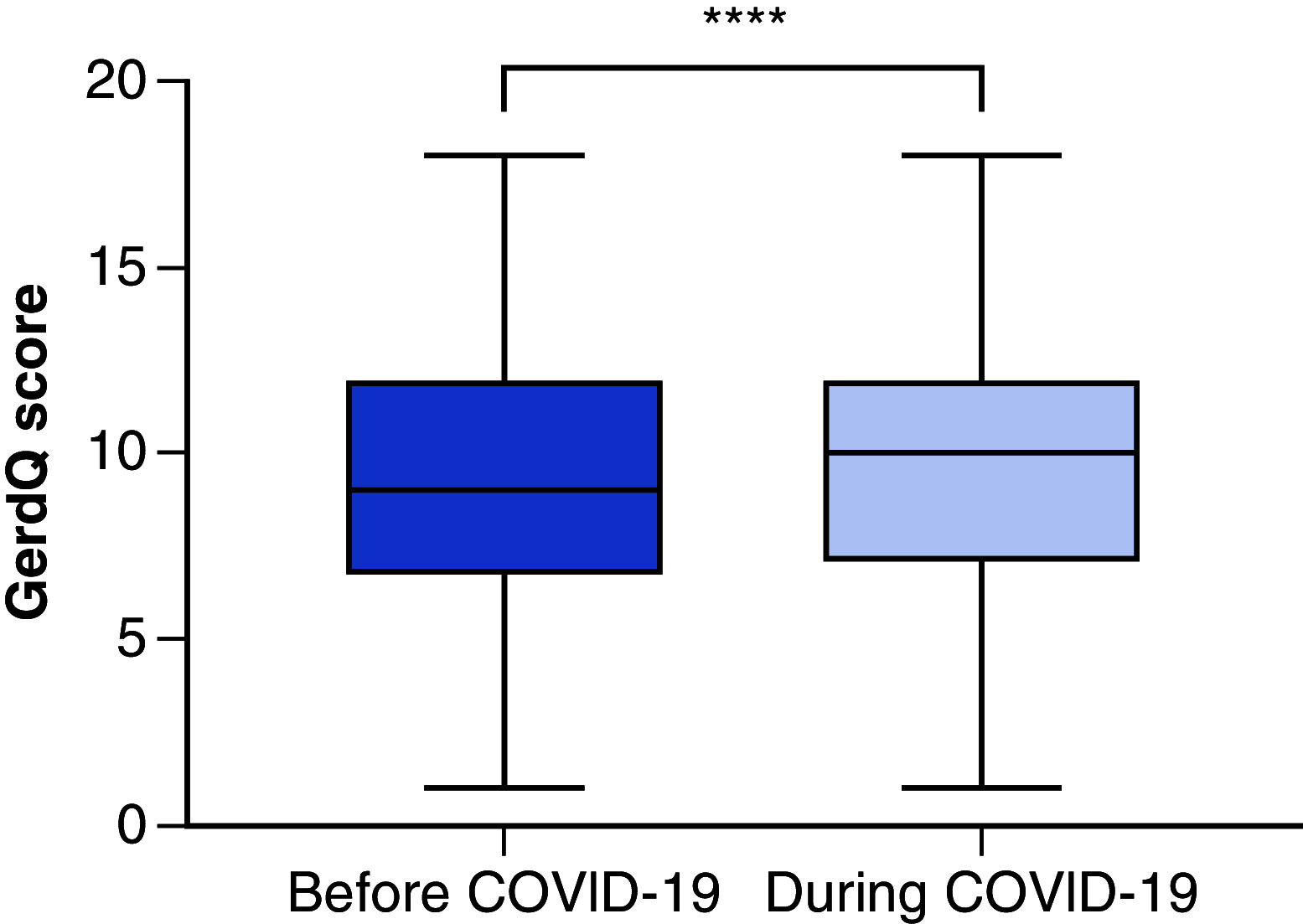Gastroesophageal reflux in lockdown
- PMID: 37228859
- PMCID: PMC10203906
- DOI: 10.2144/fsoa-2023-0042
Gastroesophageal reflux in lockdown
Abstract
Aim: This study examines the changes in gastroesophageal reflux disease (GERD) symptom frequency among patients with GERD throughout the COVID-19 pandemic.
Methods: A structured questionnaire was distributed among 198 GERD patients. The questionnaire consisted of a demographic characteristic assessment, the GerdQ questionnaire, and a reflux symptom index (RSI) questionnaire.
Result & conclusion: A statistically significant increase in GerdQ score was identified among participants during the COVID-19 pandemic (t = 7.055, df = 209, p < 0.001), who had experienced an increase in the frequency of positive predictors of GERD and a decrease in the frequency of negative predictors of GERD. The COVID-19 pandemic and its related lockdown countermeasures may have led to exacerbating and worsening GERD symptoms.
Keywords: COVID-19; COVID-19 lockdown; gastroesophageal reflux; gastroesophageal reflux disease; gastrointestinal system.
Plain language summary
There is a lack of decisive research into the impacts of the COVID-19 pandemic and its lockdown countermeasures on patients with GERD. We investigated the changes in symptomatic frequency among GERD patients in Jordan during the COVID-19 pandemic in a cross-sectional study involving 198 GERD patients. A statistically significant number of participants experienced an increase in the frequency of positive predictors of GERD, and a decrease in the frequency of negative predictors of GERD. In addition, the impacts of GERD itself were also found to have increased during the pandemic, with patients struggling to sleep or attain additional medication to treat their condition.
© 2023 Hafez Al-momani.
Figures



Similar articles
-
Prevalence and clinical predictors of LPR among patients diagnosed with GERD according to the reflux symptom index questionnaire.Saudi J Gastroenterol. 2018 Jul-Aug;24(4):236-241. doi: 10.4103/sjg.SJG_518_17. Saudi J Gastroenterol. 2018. PMID: 29652032 Free PMC article.
-
Clinical Implications of the Gastroesophageal Reflux Disease Questionnaire and Reflux Symptom Index in Patients With Suspected Laryngopharyngeal Reflux Symptoms.J Neurogastroenterol Motil. 2022 Oct 30;28(4):599-607. doi: 10.5056/jnm21235. J Neurogastroenterol Motil. 2022. PMID: 36250367 Free PMC article.
-
Validation of the Korean Version of the Gastroesophageal Reflux Disease Questionnaire for the Diagnosis of Gastroesophageal Reflux Disease.J Neurogastroenterol Motil. 2019 Jan 31;25(1):91-99. doi: 10.5056/jnm18133. J Neurogastroenterol Motil. 2019. PMID: 30646480 Free PMC article.
-
Predictive Factors of Gastroesophageal Reflux Disease Symptoms Following Open Sleeve Gastrectomy in Brazil Using Clinical Questionnaire.Obes Surg. 2021 Jul;31(7):3090-3096. doi: 10.1007/s11695-021-05333-w. Epub 2021 Mar 16. Obes Surg. 2021. PMID: 33725297
-
Effectiveness of the Gerdq Questionnaire for Diagnosing Gastroesophageal Reflux Disease After Esophagectomy for Esophageal Cancer.Kurume Med J. 2023 Apr 4;68(1):25-31. doi: 10.2739/kurumemedj.MS681004. Epub 2023 Feb 8. Kurume Med J. 2023. PMID: 36754379
Cited by
-
COVID-19 and Its Sequelae Masquerading as Gastrointestinal Ailments: A Report of Gastroesophageal Reflux Disease (GERD) and Review of Recent Cases.Cureus. 2024 Apr 4;16(4):e57617. doi: 10.7759/cureus.57617. eCollection 2024 Apr. Cureus. 2024. PMID: 38707018 Free PMC article.
-
Critical appraisal of how COVID-19 infection and imposed lockdowns have impacted gastroesophageal reflux: A review.Medicine (Baltimore). 2024 May 10;103(19):e38074. doi: 10.1097/MD.0000000000038074. Medicine (Baltimore). 2024. PMID: 38728518 Free PMC article. Review.
-
Physical Activity as a Modifiable Risk Factor for Gastroesophageal Reflux Disease in Saudi Arabia: A Systematic Review and Meta-Analysis.Cureus. 2025 Jun 3;17(6):e85271. doi: 10.7759/cureus.85271. eCollection 2025 Jun. Cureus. 2025. PMID: 40621247 Free PMC article. Review.
-
Gastroesophageal reflux disease increases predisposition to severe COVID-19: Insights from integrated Mendelian randomization and genetic analysis.Ann Hum Genet. 2025 Jan;89(1):54-65. doi: 10.1111/ahg.12584. Epub 2024 Nov 12. Ann Hum Genet. 2025. PMID: 39530352 Free PMC article.
References
-
- Hoffmann M, Kleine-Weber H, Krüger N, Müller M, Drosten C, Pöhlmann S. The novel coronavirus 2019 (2019-nCoV) uses the SARS-coronavirus receptor ACE2 and the cellular protease TMPRSS2 for entry into target cells. BioRxiv 1–23 10.1101/2020.01.31.929042 (2020). - DOI
-
- Zhang H, Kang Z, Gong H et al. The digestive system is a potential route of 2019-nCov infection: a bioinformatics analysis based on single-cell transcriptomes. BioRxiv 1–26 10.1101/2020.01.30.927806 (2020). - DOI
LinkOut - more resources
Full Text Sources
Miscellaneous
